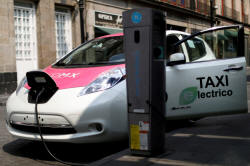Biden infrastructure plan takes on EV charging’s inequality problem
 Send a link to a friend
Send a link to a friend
 [September 01, 2021] By
Tina Bellon [September 01, 2021] By
Tina Bellon
(Reuters) - The Biden administration has an
ambitious $7.5 billion plan to expand electric vehicle charging to
underserved areas, but it must first overcome a host of obstacles that
have discouraged private investment in more equitable charging networks.
The experience of California - the U.S. state with the largest number of
EVs and the most advanced charging infrastructure - shows how
challenging it will be to achieve the goals in the $1 trillion
infrastructure spending proposal Biden wants Congress to pass.
California has poured more than $2 billion into a variety of EV
incentive programs over the last years, which include policies to
promote equity in distribution of chargers. The state has also generated
more than $25 billion through its carbon credits trading program since
2012, a portion of which goes toward EV and charging projects.
Nevertheless, California currently has less than 40% of the charging
infrastructure needed to support projected EV growth by 2025, according
to a U.S.-wide charging gap study by the International Council on Clean
Transportation.

Lower-income areas in largely Black and Hispanic California
neighborhoods continue to be significantly less likely to have access to
public chargers, a February study by researchers at California's
Humboldt State University found.
"For charging site hosts, the economics are extremely challenging
because of the relatively low adoption of EVs today," said John Gartner,
senior director at the Center for Sustainable Energy, which administers
EV incentive and infrastructure programs on behalf of six U.S. states,
including California.
For a graphic on charging economics:
https://graphics.reuters.com/USA-INFRASTRUCTURE/EVCHARGING/
egvbkklbkpq/chart.png
ONLY A DOWN PAYMENT
Gustavo Occhiuzzo, the CEO of California-based electric vehicle charging
company EVCS, said the level of public support to defray upfront and
operational costs is the key to decisions on building out his charging
network in rural and disadvantaged communities.
"We need to be strategic where we invest our time and money. And for
now, California is the one place that provides the biggest return for
us," said Occhiuzzo, whose company maintains more than 1,500 chargers in
largely disadvantaged California communities - and turns a profit.
Most of the private charging companies, however, such as EVgo,
ChargePoint and Blink Charging Co, have yet to be profitable. Executives
at EVgo and ChargePoint said government support was needed to expand
charging to overlooked communities and create incentives for business
owners or landlords considering installation.
California's incentives for disadvantaged communities are gradually
increasing. Applications for the state's EV rebate program from low- and
middle-income households have increased to a quarter so far this year,
and around a third of funding for a popular state EV charging program is
earmarked for disadvantaged communities.
Replicating California's programs on a national scale will require
vastly more funding than the U.S. government has currently allocated.

Daniel Davenport, senior director of automotive at Capgemini Americas,
estimates it would require around $50 billion to build out the U.S.
charging network.
[to top of second column] |

A taxi electric is plugged in at a charging point for electric
vehicles in Mexico City, Mexico, March 6, 2018. REUTERS/Edgard
Garrido

Getting more Americans to switch to a battery-powered car by improving access to
charging infrastructure is a key component of Biden's agenda to combat climate
change, with transportation accounting for the largest share of U.S. emissions.
The $1 trillion bipartisan infrastructure bill provides for $7.5 billion in
charging network investments over a five-year period, with a portion set aside
for low-income and rural areas.
A White House official said the government would also use Department of Energy
loan programs and other financing tools, prioritizing public funding for
locations that would not necessarily be supported by private capital alone.
"As the administration... develops the guidance for these new programs we will
emphasize the importance of equity in the siting and operation of chargers," the
official said.
UTILIZATION RATES
State and federal officials face a two-prong challenge to expand charging beyond
high-income zip codes: Battery-powered vehicles are still out of reach of many
consumers, and a charger that is not used heavily will not recoup its costs.
High-speed charging units that can top up a vehicle battery in half an hour cost
around $100,000 to build. Experts estimate they need to be used at least 20% of
the day to operate profitably at current rates - prompting many charging
providers to place them in areas with higher anticipated use.
In the future, used EVs could allow less-affluent Americans to drive
battery-powered vehicles. Currently, used EVs account for only 0.3% of all U.S.
franchise dealer used sales, compared with new EVs making up 3% of new vehicle
sales, according to market research firm J.D. Power.
"It's going to be a very long time before EVs are a significant part of the used
market," said Tyson Jominy, the firm's vice president of Data & Analytics.

Beyond government agencies, electric utilities are emerging as source of capital
to expand charging networks, owning stations themselves or partnering with
private companies.
Investor-owned utilities have approved $3 billion in EV charging infrastructure
investments in recent years, according to the Edison Electric Institute,
dominated by entities in California and New York. A quarter of those funds has
been allocated to disadvantaged communities, and equity-based funding programs
are expected to accelerate in the coming years.
In North Carolina, Duke Energy has asked state regulators to approve a $56
million electric vehicle program, which includes $13 million for rural and
low-income communities.
"We're making sure to hit those low-income rural counties that would likely be
underserved by the traditional private market, areas a private company wouldn't
select until EV adoption is further down the road," said Lon Huber, a Duke
Energy vice president.
(Reporting by Tina Bellon in Austin, Texas; Editing by Dan Grebler)
[© 2021 Thomson Reuters. All rights
reserved.] Copyright 2021 Reuters. All rights reserved. This material may not be published,
broadcast, rewritten or redistributed.
Thompson Reuters is solely responsible for this content. |